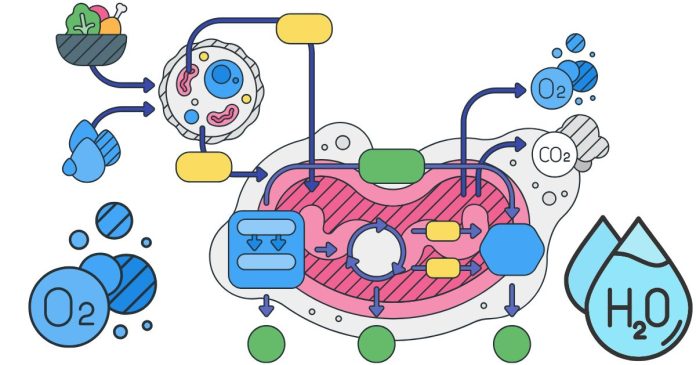Cellular respiration is a critical biochemical process by which cells generate energy, in the form of adenosine triphosphate (ATP), to power a variety of cellular activities. This process involves the breakdown of glucose (or other nutrients) in the presence of oxygen and produces carbon dioxide, water, and ATP. Cellular respiration occurs in distinct stages, and different stages take place in specific locations within the cell. Understanding where these processes occur is fundamental to understanding cellular metabolism and energy production.
Key Stages of Cellular Respiration
Cellular respiration can be broken down into three main stages: glycolysis, the citric acid cycle (Krebs cycle), and the electron transport chain. Each of these stages takes place in different parts of the cell, and they work together to convert energy stored in glucose into usable ATP.
1. Glycolysis – The Cytoplasm
Glycolysis is the first stage of cellular respiration and takes place in the cytoplasm of the cell, outside of the cell’s mitochondria. This process involves the breakdown of one molecule of glucose (a six-carbon sugar) into two molecules of pyruvate (a three-carbon compound), producing a small amount of ATP and NADH in the process. Importantly, glycolysis does not require oxygen and is therefore an anaerobic process.
- Location: Cytoplasm
- Key Outputs: 2 ATP, 2 NADH, 2 Pyruvate molecules
Even though glycolysis produces relatively little ATP compared to later stages, it is a crucial first step in cellular respiration, providing the pyruvate that will enter the mitochondria for further processing.
2. Citric Acid Cycle (Krebs Cycle) – The Mitochondrial Matrix
The next stage of cellular respiration, the citric acid cycle (also known as the Krebs cycle), occurs inside the mitochondria, specifically in the mitochondrial matrix. The two pyruvate molecules produced during glycolysis are transported into the mitochondria, where they are converted into acetyl-CoA and enter the citric acid cycle.
During the citric acid cycle, acetyl-CoA combines with a four-carbon molecule to form citric acid (a six-carbon compound), which undergoes a series of reactions, producing high-energy electron carriers (NADH and FADH2) and releasing carbon dioxide as a waste product. The cycle also generates a small amount of ATP. The high-energy electron carriers produced during this cycle are crucial for the next step of cellular respiration.
- Location: Mitochondrial matrix
- Key Outputs: 2 ATP (per glucose molecule), 6 NADH, 2 FADH2, 4 CO2
The citric acid cycle is an aerobic process, meaning it requires oxygen indirectly, as it relies on the electron transport chain, which requires oxygen to function properly.
3. Electron Transport Chain – The Inner Mitochondrial Membrane
The final stage of cellular respiration is the electron transport chain (ETC), which takes place in the inner mitochondrial membrane. The high-energy electron carriers (NADH and FADH2) produced during glycolysis and the citric acid cycle deliver electrons to the electron transport chain, where they are passed through a series of protein complexes. As electrons move through these complexes, energy is released and used to pump protons (hydrogen ions) across the inner mitochondrial membrane, creating a proton gradient.
This proton gradient powers the enzyme ATP synthase, which synthesizes ATP by allowing protons to flow back into the mitochondrial matrix. Oxygen is essential at the end of the electron transport chain, where it acts as the final electron acceptor, combining with electrons and protons to form water. Without oxygen, the entire chain would halt, and ATP production would cease.
- Location: Inner mitochondrial membrane
- Key Outputs: Approximately 32-34 ATP, H2O (water as a byproduct)
This stage produces the majority of the ATP generated during cellular respiration and is therefore essential for energy production in the cell.
Summary of Where Cellular Respiration Occurs in a Cell
- Glycolysis occurs in the cytoplasm.
- Citric Acid Cycle (Krebs cycle) occurs in the mitochondrial matrix.
- Electron Transport Chain occurs in the inner mitochondrial membrane.
Each of these stages plays a vital role in the overall process of converting chemical energy from nutrients (primarily glucose) into a form (ATP) that cells can use to perform their functions.
Why Are Mitochondria Important?
Mitochondria are often referred to as the “powerhouses” of the cell because they are the site of the citric acid cycle and electron transport chain, where the majority of ATP is produced during cellular respiration. These organelles are critical for the production of energy required to support life processes, from muscle contraction to nerve signaling to protein synthesis.
Cellular respiration is a multi-step process that occurs in different parts of the cell. Glycolysis takes place in the cytoplasm, while the citric acid cycle and electron transport chain occur in the mitochondria. Each stage of this process is crucial for converting energy from nutrients into ATP, the cell’s primary energy currency. By understanding where each of these stages takes place, we gain a clearer picture of how cells efficiently produce the energy they need to function.


